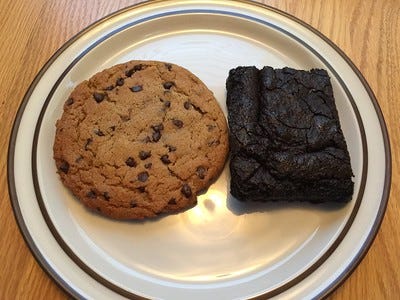
Every living thing has a genome - a set of instructions that guide minute biological machines as they build a plant, animal, bacteria or fungus from a single cell. During development these minute machines, copying machines if you will, make new cells and after they copy the sent of instructions more or less faithfully. Other machines, the builder machines, use the instructions to create different parts of the body and, unltimately, a whole organism. But what happens when copied instructions aren’t exactly the same as the original? In some cases the change makes absolutely no difference. In some other cases, the changes is not consistent with a healthy, thriving life. In a third scenario, the change in the instructions leads to a new variety that is mostly like original plan, but not exactly - this is how the variation that is an intergal part of evolution by natural selection comes to be.
Take for example, a recipe for cookies that specifies the type and amount of ingredients, the mixing process, and the baking temperature. Say that somewhere along the way, the copying machines changed baking soda to baking powder. Both can be used to make tasty cookies, but there are also some differences1. Baking soda (a.k.a. sodium bicarbonate or NaHCO₃) neutralizes the positive electrical charge found on the proteins in flour, eggs, and milk and make it possible for the cookies to spread and and set in the oven. Baking soda also helps the cookies brown as the Maillard reaction occurs. Baking powder is part sodium bicarconate, but and part cream of tartar (a.k.a. potassium bitartrate or (KC4H5O6)). The cream of tartar adds additional acid to the mix. As the baking powder dissolves in the presence of heat it releases carbon dioxide and creates air bubbles that leaven the dough. Think of the differences between brownies and cookies. Brownies, which use baking powder, are cake-like and gooey. Cookies, which use mostly baking soda, are chewy or crisp.
The point? You can think of the genome, or genotype, as the recipe and the phenotype as the product that the recipe makes. Evolution can occur when a copying error changes baking power to baking soda in the recipe. Now you have two recipes - one for cookies and one for brownies. Over time, some places end up with only cookies and other regions have only brownies. Now think of a plant or animal. Over time, copying errors occur that create a new phenotype, or variation of the recipe. Over time, the relative proportions of each variety changes. And that, in a nutshell, is evolution.
This blog post written by Dee of One Sarcastic Baker and posted by Gemma at Bigger Bolder Baking has a fantastic! easy to follow! explaination of the chemical differences between baking soda and baking powder.



